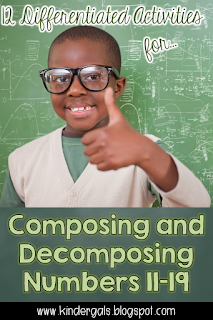“When learning is active and hands-on, the formation of neural connections is facilitated and information is much more readily remembered than information learned from an abstract viewpoint, where the teacher is doing the word while the students watch.” Wow! That’s pretty powerful on its impact to our teaching. So hold on…this is going to be a long post. I couldn’t decide which ones to share, so I’m sharing them all! This chapter makes me think of something I learned about Math Instruction…

So what does this mean? It means that ALL LEARNING should be at a conceptual level! This means real objects, things that can be manipulated.

For example, in this story problem, the kids are using plastic teeth to figure out the answer—that’s conceptual.

And these kids drew a picture to figure out the answer. This is the pictorial level. Sometimes when our kids have difficulty here, we think it is because they don’t understand the problem. But, really, if we just change HOW the children are learning to a manipuative, that might be successful. The last level is abstract. This is when the children solve the problem FIRST using numerals and symbols. Now….once your kids get to this level….we still want them to show how they solved the problem through drawings or manipulatives. It is just that the solving of the problem was done abstractly.
Here’s a few dollar store ideas on manipuatives that you can make super cheap!

Here’s a great way to work on mixed operations. The mouse is just a cat toy, they came 3 to a bag. I stuck a pipe cleaner in the back side, collected a dice, and some pony beads!
Here’s how you play:
- Give each child a mouse and some beads.
- The children roll the dice and put that many beads on the pipe cleaner.
- Roll again. Now they must decide whether they need to put some on (addition) or take some off (subtraction.)
- If they have 5 beads on the tail and they roll a 3, then they take 2 beads off of the tail.
Here’s another example of the same game using rubber ducks and a bowl of water! What is it about water?!!!??? Kids love it!

Another great way to use manipulatives is by using number bonds. Scroll to the bottom to grab this FREE Number Bond Mat.

My smart friend, Catherine Kuhns, once told me that this is the way we should say it:
- First, start with the whole… “I have 5 gingerbread men.”
- Then, say the two groups…. “I have two gingerbread men, I have 3 gingerbread men.”
- Last, say the whole again…. “I have 5 gingerbread men.”
Why? Because this way the kids see that nothing happens to the gingerbread men when you divide them into two sets. When you bring them back together, you still have the same amount. Remember Piaget and Conservation of Number from your college days?
Marcia also talked about the importance of clay. I’m wondering how many classes still use a playdough center? I know, I know…. it’s messy, it gets stuck in the carpet, it dries out… But, Marcia reminded me of why we are doing it! It makes them smarter! Here are a couple of ideas we did during our shape unit.


So what about that block center? Do you still have one? It is sad that sometimes in an attempt to “improve test scores”, to “add rigor”, to “get them ready”……the very things that will do just that are eliminated. I keep going back to something from one of the earlier chapters….we are trying to makeSMARTER children. REAL learning does just that!


I made up some easy cards with real world problems and ask the kids to figure out how to solve the problem using the blocks! This was amazing!
And last, a few science experiments. One thing that Marcia said was that kids need to be the ones doing the experiment, not sitting and watching the teacher do them. So….I try to keep them really simple! You can find other science experiments (
here).


My friend Bert actually gave me this idea, I just “fancied” it up a bit.


And now…here’s the last one…
Ever read kids a book and they “don’t get it”. In this story, baby duck doesn’t like the rain. If kids are lacking the schema about ducks feathers, they will not be able to understand why the parents tell him he is a duck and ducks like rain. So here’s what we did…
- First, read some nonficiton information about ducks and their feathers.
- Then, test it out with this simple experiment.
- Last, read the book and ask the kids why baby duck is being silly. They will “get it” now!
This quote from Marcia’s book sums everything up: “Students in the early grades should be allowed to use manipulatives for as long as the students feel they are needed.”
Now head on over to Deanna’s blog to see what other teachers are sharing!









































































